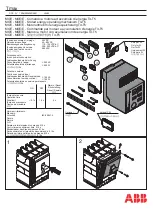
15. To put circuit breaker into service push
interlock to left, insert
lever in
bottom
3. Make sure all retaining rings are in place.
bole of the
mechanism (Figure 8) and
4. Surfaces marked “F” should be lubricated by thin
upward stroke rack breaker into operating position.
of “Conducto-Lube
before assembly.
Remove
lever. interlock
should
in
Contacts must be inspected after every known short circuit
and should also he
at regular in-
spect& periods. If contacts are found to be worn or
cessively pitted they should be dressed or replaced.
When
reinstalling the arc chutes, adjust the
retaining screws on the arc chute retaining bar so that
the contact insulating block clears the arc chute base when
the breaker is closed.
CONTACT ASSEMBLY
repair or replace
arcing contacts,
follows (Figure 11)
1.
stored energy
2. Remove arc chutes and
barrier.
3. Remove insulating block and
fork assembly.
4. Tighten
arcing
adjusting screw
Figure 9 Figure
PART 4
MAINTENANCE
The breakers with all component
have been
tested for performance as per
Standards SG
3 and ANSI
and proved to be satisfactory
wide margin of safety.
solid and
retaining pins.
6. Remove arcing
contact pivot pin and replace
arcing contacts.
contacts should be replaced at
one time.
6. Make
nylon bushings on arcing
pivot pin
are in place and in good condition, when replacing
arcing contact.
A periodic maintenance
should be established. An
annual inspection should
made for clean,
applications. More frequent inspections should be made
for dirty, corrosive or high-use applications.
Reassemble following the reverse
of operations
and adjust per Figs. 10 and 11. In most
it is not
to replace contacts, but occasional
and readjustments are
recommended.
The following instructions and
should be fol-
lowed carefully:
CONTACT ADJUSTMENT
Figure 10 and 11
MAIN AND ARCING CONTACTS ADJUSTMENT
FOR
AND
BREAKERS
To replace stationary arcing contacts (Figure
remove
unit pole assembly, replace main stud and arcing contact
assembly, part 1151-9939, for 600A breaker and
9937 for
breaker.
Adjust
as per
10, 11 12.
“A” Main Contact Pressure
Over Travel Mains
Arcing Contact Press
Gap (distance) between
mains when arcing
contacts touch
42-50 lbs., measured at
point of contact
lbs., measured at
of contact
&
(Fig. 10)
CHECK POINTS
-Figure
11 and 12
1. Stationary arcing contacts
make sure that retaining
screws and contacts are tight.
2. Main contacts should be clean and free



























